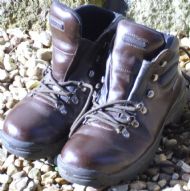Ashby Rambler's Blog Archive
Some rambling thoughts and observations on local and national issues.
Your comments are welcome - please use the form below.
Which way now?
by Ashby Rambler - 15:22 on 14 June 2014

This fine example of signposting excellence has triggered some rambling thoughts on some peculiarities of signage and waymarking.
How often, for example, do we spend valuable rambling time figuring out which gate we should be opening and in exactly which direction we should traverse the next field, simultaneously cursing the apparently missing waymark - only to discover that a perfectly adequate and carefully aligned arrow is attached to the reverse side of the gate, usefully pointing out where we’ve already been?
Having been a path warden, the Rambler appreciates that resources are limited but also that there are few (if any) footpaths or bridleways that are ‘one way only’.
This problem could be more than an inconvenience. The Rambler recently climbed a stile and was belatedly informed, again on the reverse side, that there was possibly a bull in the field - this is quite simply dangerous.
Then there is the confusion that arises when negotiating a complex convergence of three or four possible paths (usually in the middle of nowhere in particular) and finding that each is helpfully labelled ‘footpath’without any clue as to its destination. Out comes the trusty compass and OS Explorer and, after lengthy discussion with a companion or self -examination if solo, a calculated guess sends us forth in hope. Spotting a white disc in the corner of the next field we march confidently up to it only to discover that it is weathered well beyond legibility and the above rigmarole with map, compass and guesswork begins all over again.
At the other end of the scale, are those signs that inform the weary wanderer of the blindingly obvious. An example is below:

It is no revelation that unsurfaced paths tend to muddiness in Winter - wouldn’t we rather know where the muddy path is taking us and how far it is to that destination?
Distances are often given on named longer trails (though sometimes clearly inadequate and contradictory - the distance between two signposts, for instance, can differ dependent on your direction of travel) but infrequently on shorter local routes.
On paths such as the above, we can, of course, resort to following the tracks of previous users - particularly when the mud is of a satisfactory consistency to reveal clear bootprints. The downside to this system is revealed when, having faithfully followed the prints we realise that our invisible guide had no better idea of the correct route than we have and the prints we assumed were those of another wanderer travelling in the opposite direction were in fact evidence of retreat in defeat, there being an impassable river, sheer drop, six-lane motorway or equivalent ‘no-go feature’ ahead.
At least prohibitive signage, though often rudely succinct and sometimes dishonest, tends to be fully informative. The Rambler need not give examples of these as they are hardly rare. We are continually reminded that roads, drives, beaches etc. are PRIVATE and therefore ‘out of bounds’ to those with no financial interest in them.
How refreshing,therefore, when a new permissive path is discovered on a previously well-known route, giving us a new perspective on a familiar landscape while we contemplate the possibility that some landowners might actually welcome us - particularly if we follow these courteous requests:

You can't really argue with that, can you?
Add your comment



